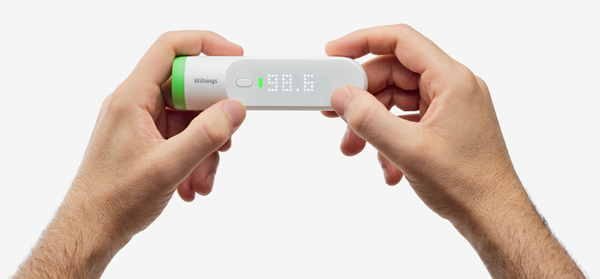
Taking a temperature is something we do when we or our kids are sick. There are old fashioned glass thermometers, more modern digital thermometers, higher tech thermometers that plug into your smartphone and then there’s the Withings Thermo. Withings, the well-known and well-respected health products brand has added the battery powered Thermo thermometer to their product line. The Thermo does not go in your mouth, in your ear or in another orifice. It doesn’t even need to touch your skin to take a reading. How does it work?
Thermo measures from the temporal artery, considered the best place to detect temperature changes, as the blood that circulates there comes from the core of the body. As Thermo sweeps across the forehead, 16 infrared sensors take over 4,000 measurements to find the hottest point. This is the revolutionary advance, and is what we call HotSpot Sensor™ Technology.
It takes only 2 seconds to get a reading which instantly shows up on the large easy to read LED display. Then Thermo syncs via Bluetooth or WiFi with a mobile app to keep a history of readings and symptoms.
The Withings Thermo is priced at $99.95 from Withings. I have one and will be posting a review soon. If you have any questions that you would like me to cover in the review, please leave them below.



Gadgeteer Comment Policy - Please read before commenting
DO NOT STICK IN……… No really don’t do it.
Ouch!
Hey we told you…… You didn’t listen.
On a side note, I never realized how old my Profile pic was. Yikes.
I’ll be interested in how reproducible the readings are. My point of comparison is a Scanadu Scout I got from Indigogo as an “investigational device” – it apparently is also getting its readings (temperature, BP, heart rate) from the temporal artery, but it has one LED and positioning it correctly on my forehead can be difficult.
When you say reproducible, do you mean you want me to take multiple readings one after the other to see if the readings are the same? Or do you want me to use multiple temperature recording devices to make sure they all match. Or all of the above? 😉
I mean if you take multiple readings one after another, what is the variance, if any? I’m wondering how reliable it is to take just one reading and assume that it is correct within, say, half a degree.
I’ll make sure to try that and other testing and write about it in the review.
Betty,
I also have the Scanadu Scout from the Indigogo campaign. I feel the readings are pretty accurate, but there are times when the device struggles to get a reading before timing out. I wonder when they will get FDA approval. They’ve been spending a lot of time testing and doing studies, for sure.
As someone who has gone through the FDA, UL, and half a dozen other approval process’s I can attest to it being a slow, painful, and expensive process. Anything that is medical or health related gets raked over the coals.
I am very interested to hear the results of your testing. This sounds like a very easy device to use and easy to read. I, too, am interested in the accuracy of the readings; do you need to take several to obtain an accurate temperature read?